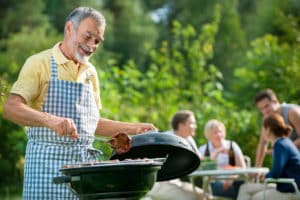The Best Ways to Pack a Picnic During National Picnic Month
Are you likely to pack a picnic and get your dad out of the house during July’s National Picnic Month? Many are planning outings, but some don’t know how to safely pack a picnic. Whether your foods are all set and ready to eat or you’re bringing items to grill, you need to pack the items safely to prevent food poisoning.
Pack Two or More Coolers

Home Care Media, PA:National Picnic Month
Fill a minimum of two coolers halfway with ice or ice packs. Reserve more ice to place on top of the items.
One will have your raw meats. If you’re serving burgers and chicken or some other mix of meats, make sure each one is secure in leak-proof packaging. You don’t want cross contamination at any stage of the picnic. Gallon-size freezer bags work well for this. Cover the meats with additional ice.
If you’re not grilling meats, package your sandwiches in the first cooler instead. Wrap them individually to avoid having something like a tuna salad sandwich leaking juices onto a cheese and tomato sandwich.
Salads go into another cooler. Make sure the salads are safely stored in leak-proof containers or freezer bags. Settle them into the ice and put a thin layer of ice over the top to ensure all sides of the bowl or package are chilled.
If you’re bringing beverages, you’ll want a third cooler for drinks. Jars of marinades and sauces can also go into this cooler.
Items that don’t need refrigeration, such as potato chips or crackers, are okay in tote bags. You can add things like paper plates and utensils to this bag.
Don’t Forget These Essential Items
There are a few things related to cooking that you need to bring. If you are grilling, you’ll need matches or a lighter. You may want charcoal and paper or lighter fluid. If you’re collecting dry wood and kindling at the park, make sure you know to collect hardwood like maple and not softwood like pine.
Bring an instant-read food thermometer. For a meat to be safe to eat, it must reach the right internal temperature. For example, chicken and turkey must be 165 F. Cutting into a piece of meat to see if it’s still bloody is not a safe way to ensure a food’s safety.
Is Your Dad Eating Safely at Home?
Who makes sure the foods your dad eats the rest of the time are safe? Is he constantly checking his fridge and cupboards for outdated or spoiled foods? Does he know how to safely cook meats? If not, it’s time to investigate the benefits of home care.
He can have someone cooking his meals for him, taking him shopping, and helping him put things way while they’re still fresh. A home care representative can help you figure out services that will benefit his desire to age at home.
If you or an aging loved one are considering Home Care in Media, PA, please contact the caring staff at True Direct Home Health Care today.
- How Home Health Providers Offer Education Amidst Physical Health Changes - March 5, 2024
- Spring Activities for Seniors - February 21, 2024
- How to Help an Older Loved One with Cataracts? - February 6, 2024
